Your Guide to SaaS Affiliate Programs
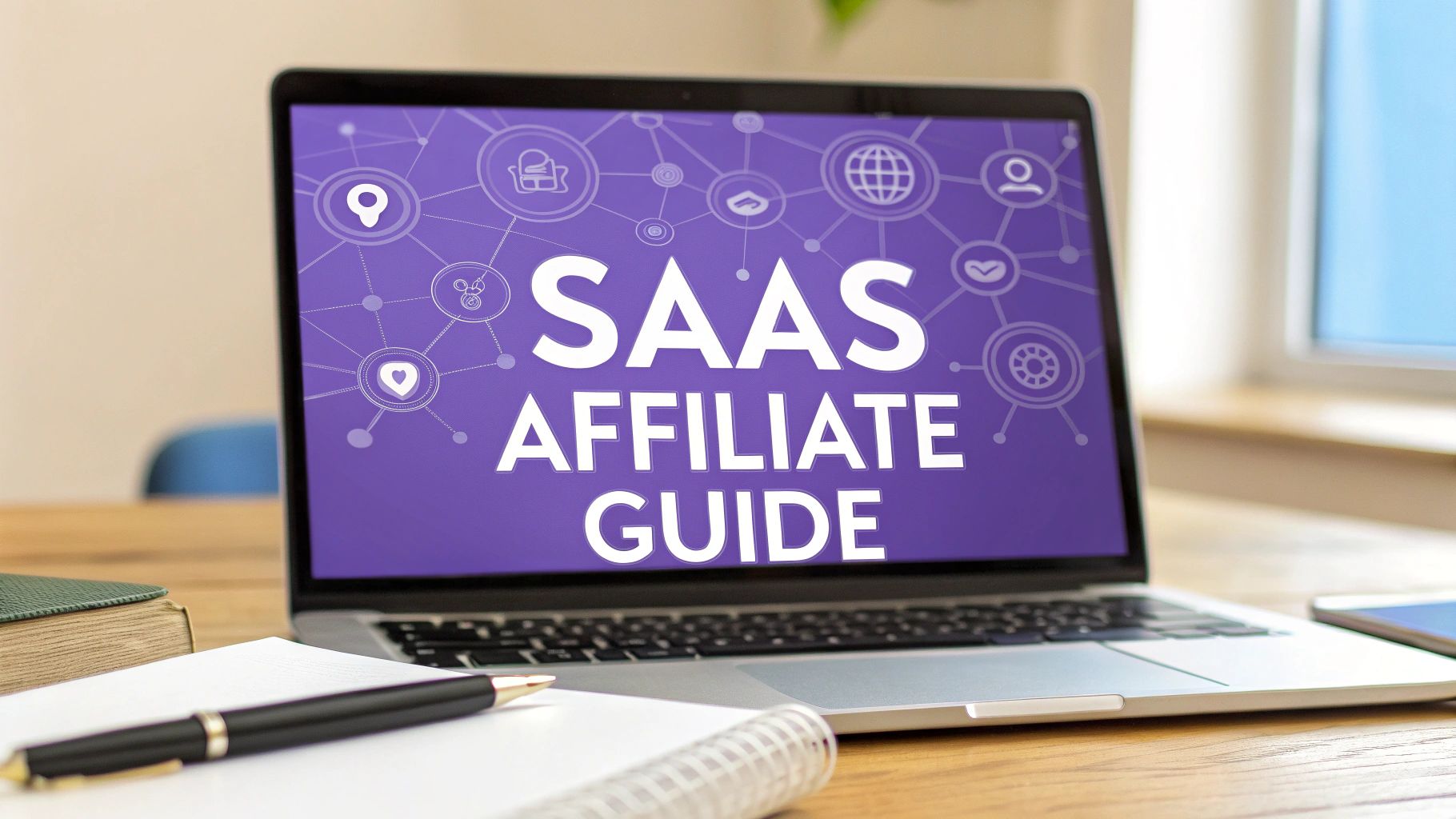
SaaS affiliate programs are a partnership where you pay people—your affiliates—a commission for sending you new customers. But what truly makes them a powerhouse for SaaS is the focus on recurring commissions. This isn't about a one-time payout; it's a strategic system for building a predictable revenue stream that grows alongside a community of genuine brand advocates.
Why SaaS Affiliate Programs Are a Growth Engine
Many SaaS founders mistakenly treat affiliate marketing as just another sales channel. This is a critical oversight. A well-executed affiliate program is more than a line item in your marketing budget—it’s a powerful engine for low-cost customer acquisition and building a loyal community around your product.
Here's an actionable way to think about it: traditional advertising is like renting a billboard. You pay a fixed price and hope the right people see it. An affiliate program is a performance-based model. You partner with trusted industry experts who recommend your software to their followers because they genuinely believe in it. You only pay them when they deliver a paying customer. It's a win-win.
Beyond a Simple Sales Channel
At its core, affiliate marketing is about leveraging trust. A recommendation from a blogger, consultant, or influencer your ideal customer already follows is exponentially more powerful than any ad you can run. You are strategically "borrowing" the trust they've already built with their audience.
This approach delivers tangible strategic advantages:
- Actionable Step: Identify 5-10 influencers or bloggers in adjacent niches and see who they currently promote. This is your initial target list for outreach.
- Lower Your Acquisition Costs: You're paying for results (customers), not potential (clicks or views). This keeps your Customer Acquisition Cost (CAC) predictably low.
- Build a Real Community: Your best affiliates become your most vocal fans. Actively solicit feedback from them—they'll provide priceless insights and promote your brand with an authenticity you can't buy.
Just as a strong affiliate program can fuel your growth, it’s smart to pair it with other powerful digital channels. For instance, well-planned B2B SEO strategies for lead generation can work in tandem to amplify your reach and bring in even more revenue.
The Financial Power of Partnership
The data supports this strategy. The affiliate marketing industry was valued at roughly $27.8 billion in 2023 and is on track to hit nearly $32.3 billion in 2024. For SaaS companies, a well-run program can drive up to a 30% increase in total revenue. That’s the power of turning partners into a reliable acquisition machine.
Actionable Insight: You're not just buying traffic; you're investing in partnerships that deliver high-quality, long-term customers. Customers referred by an affiliate often have a much higher lifetime value (LTV) because they arrive with pre-built trust and a clear understanding of your product's value.
Let's break down the key elements you need to build into your program to make it effective.
Core Components of a High-Impact SaaS Affiliate Program
To build a program that gets results, you need to have the right foundational pieces in place. This table outlines the must-have components for any high-performing SaaS affiliate program.
| Component | Description | Why It Matters for SaaS |
|---|---|---|
| Recurring Commissions | Affiliates earn a commission for as long as the referred customer remains a paying subscriber. | This aligns affiliate incentives with your subscription model and motivates them to refer high-quality customers who won't churn. |
| Dedicated Affiliate Portal | A dashboard where affiliates can track their clicks, referrals, and earnings in real-time. | Transparency builds trust. Giving partners easy access to performance data keeps them motivated and engaged. |
| Marketing Creatives | A library of pre-made banners, social media templates, email copy, and other promotional assets. | Actionable Step: Create a "Launch Kit" with 5-7 core assets to help new affiliates start promoting immediately. This removes friction and ensures brand consistency. |
| Clear Terms & Conditions | A straightforward document outlining commission rates, cookie duration, payout schedules, and rules. | Clear rules prevent disputes and protect both you and your partners, establishing a professional and reliable partnership. |
Having these core pieces in place sets the foundation for a program that not only drives sales but also builds lasting, profitable relationships.
This performance-based model significantly de-risks your marketing spend. Instead of investing heavily in ad campaigns with no guaranteed return, you create a system where your marketing costs are directly tied to revenue. This is why SaaS affiliate programs are one of the most scalable and predictable growth levers you can pull.
How to Structure Your Commissions for a True Win-Win Partnership
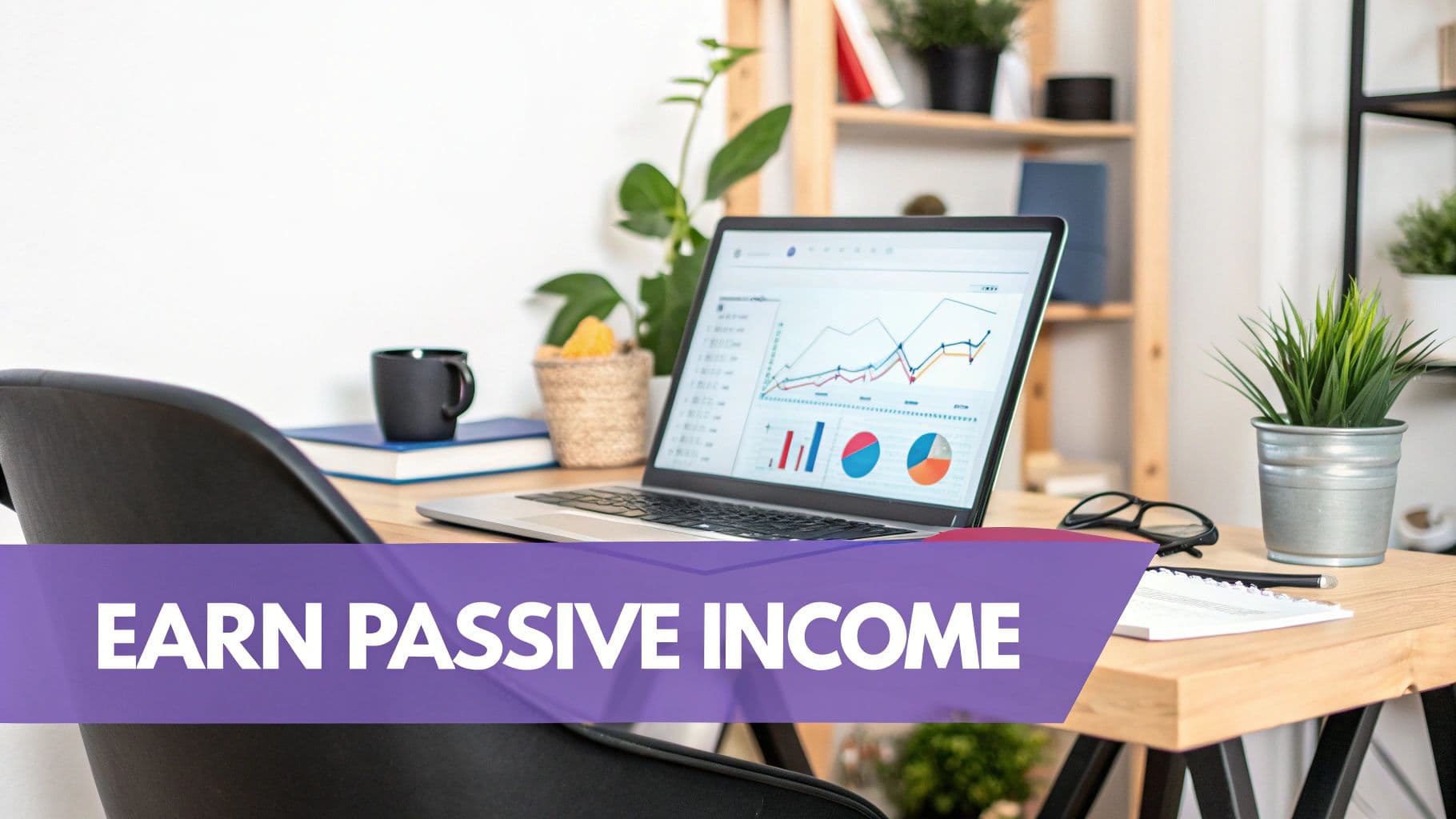
Let's get tactical about the engine of your affiliate program: the commission structure. This isn't just about offering money; it's about designing a framework that attracts top-tier partners, keeps them motivated, and determines whether your program becomes a sustainable growth channel or a costly experiment.
When you structure this correctly, you create a true partnership where your success and your affiliates' success are perfectly aligned. The decision starts with your commission model.
Recurring vs. One-Time Payouts: The Big Decision
For any SaaS business, this is the most critical choice you'll make for your program. Should you pay affiliates once per sale, or for the lifetime of the customer? In almost every scenario, recurring commissions are the right strategic move.
Your business thrives on subscriptions. When you pay an affiliate a percentage of that fee every month (or year) a customer stays active, you align their goals directly with your own. This incentivizes them to find high-quality, long-term customers—not just quick signups who churn after 30 days.
Actionable Insight: Recurring commissions transform affiliates from one-time promoters into genuine business partners. They suddenly have a vested interest in your customer retention and lifetime value (LTV).
This doesn't mean one-time payouts, or "bounties," are useless. You can use them as a strategic bonus. For instance, offer a $100 bonus for the first paid conversion in addition to a 20% recurring commission. This provides an immediate reward for their effort while locking in that long-term incentive.
Nailing Your Commission Rate
Setting the right percentage is a balancing act. You need to be competitive enough to attract top talent, but not so generous that your margins suffer. The good news is that SaaS affiliate programs are known for attractive rates, often landing between 20% and 70%.
This strong, performance-based incentive model is why over 80% of brands now have an affiliate program. It's a proven system.
To find your sweet spot, model potential payouts against your Customer Lifetime Value (LTV) and Customer Acquisition Cost (CAC). If your average customer is worth $1,200 over two years and pays $50/month, offering a 30% recurring commission is a highly sustainable investment that top affiliates will find attractive.
A powerful way to motivate your entire partner base is to implement performance-based tiers. This gamifies the promotion process and gives everyone a clear path to earning more.
Example of a Tiered Structure:
- Bronze Tier (1-10 sales/month): 20% recurring commission.
- Silver Tier (11-25 sales/month): 25% recurring commission.
- Gold Tier (26+ sales/month): 30% recurring commission + a $500 quarterly bonus.
A tiered system gives your top performers a compelling reason to prioritize your SaaS over a competitor's. To get more ideas on building these kinds of motivational structures, you can find a ton of insights in our guide on how to successfully recruit and retain top affiliates.
Don't Forget the Fine Print: Defining Your Program Terms
While the commission rate grabs attention, the other program terms signal to affiliates that you are a serious, professional partner. These details show you respect their work and have designed the partnership from their perspective.
Cookie Duration
The cookie duration (or cookie life) defines how long an affiliate gets credit for a sale after a user clicks their link. Because the SaaS sales cycle can be lengthy—a prospect might read a review today but not convert for weeks—a longer cookie window is a critical selling point.
- Standard: 30-60 days
- Competitive: 90-120 days
- Exceptional: Lifetime
Actionable Step: Offer a 90-day cookie window as a baseline. This is a strong, competitive move that tells affiliates you understand their role in nurturing leads over time and value their contribution to the entire customer journey.
Payout Schedule and Threshold
Clarity on payment terms is non-negotiable for building trust. Be upfront and specific about these details.
- Payout Schedule: Will you pay monthly? A Net-30 schedule (paying 30 days after the month's end) is a common practice that gives you a buffer for refunds or cancellations.
- Minimum Payout Threshold: Set a reasonable minimum, like $50, that an affiliate must earn before a payout is triggered. This reduces your administrative burden of processing many small payments.
By carefully structuring every component of your commission plan—from the rates to the cookie life—you create an irresistible offer that attracts the best partners to your SaaS affiliate program and drives real, sustainable growth.
Choosing Your Affiliate Platform and Tools
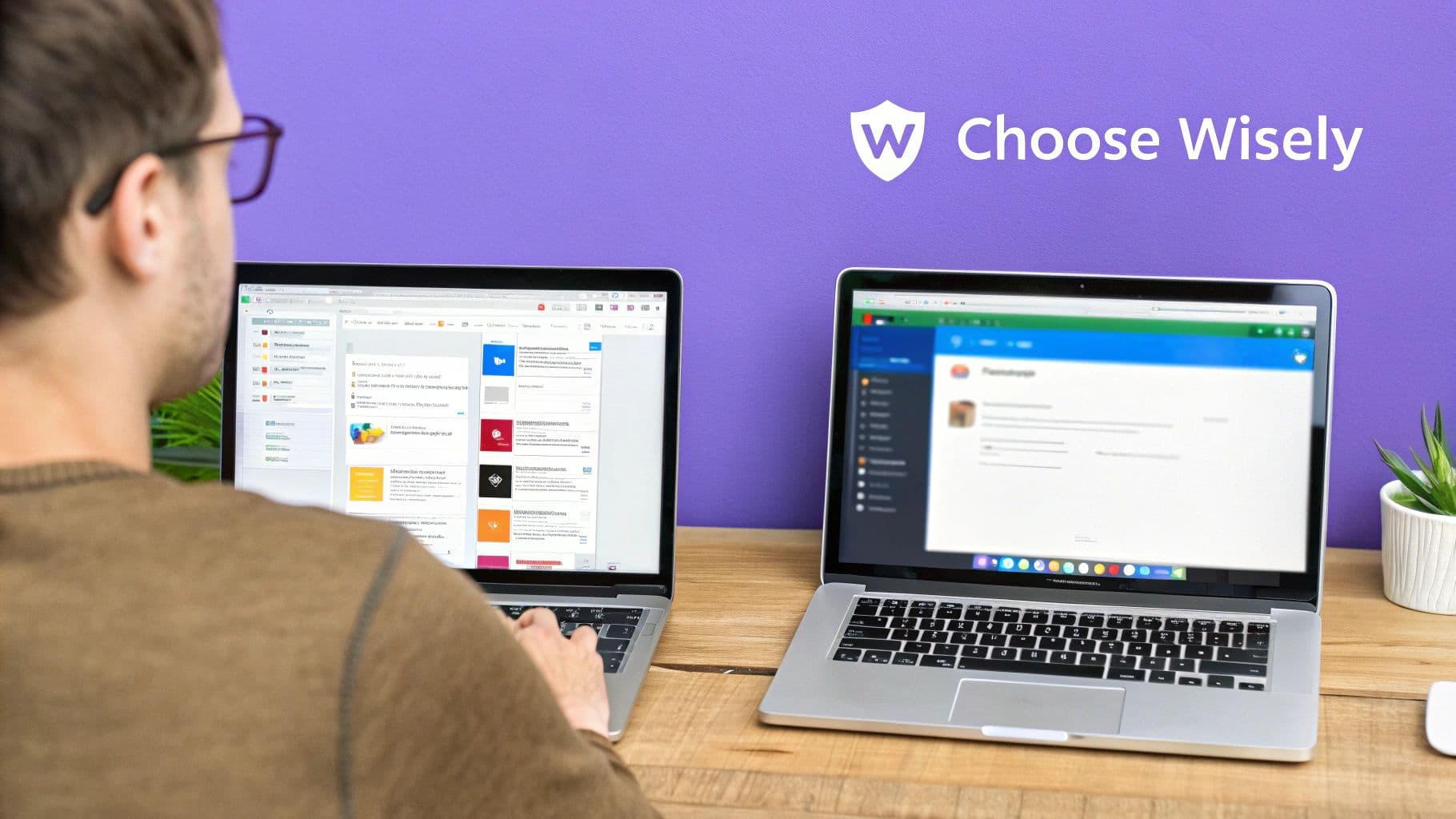
The right technology is the backbone of a successful SaaS affiliate program. It tracks clicks, manages payouts, and provides a clear view of performance for both you and your partners. Choosing a platform is a strategic decision that will shape how you manage relationships and scale your program.
Your decision comes down to two main paths: joining an established affiliate network or building your program "in-house" with dedicated affiliate software. Each has major implications for your budget, control, and ability to attract the right partners.
Affiliate Networks vs. In-House Software
An affiliate network is a pre-existing marketplace connecting you with thousands of affiliates. Platforms like ShareASale or CJ Affiliate are like placing your product in a massive online mall; you get immediate access to a large pool of potential partners.
Conversely, in-house software like our own Push Lap Growth or PartnerStack provides the tools to build and operate your own private affiliate program. This is like building your own flagship store. You gain total control over the brand experience and the direct relationship with each partner.
The core difference isn't the tech; it's ownership. Networks offer discovery but take a percentage of your revenue and limit your control. In-house software gives you that control, but you are responsible for recruiting your own partners.
Let's compare them side-by-side to help you decide.
| Feature | Affiliate Network (e.g., ShareASale) | In-House Software (e.g., Push Lap Growth) |
|---|---|---|
| Partner Recruitment | Access to a large, built-in pool of active affiliates. Easier to get started quickly. | You are responsible for all recruitment. Requires a dedicated marketing and outreach strategy. |
| Control & Branding | Your program exists within the network's interface. Customization is limited. | You get a fully branded portal on your own domain and own the partner relationship directly. |
| Cost Structure | Often involves setup fees, monthly fees, and a percentage of every commission paid. | Typically a flat monthly or annual software fee. You keep more of your revenue. |
| Relationship | The network acts as a middleman. Communication is often filtered through their platform. | You build a direct, one-to-one relationship with partners, which is crucial for fostering loyalty. |
Making the right choice here is the first step toward building a program that truly serves your business goals.
A Real-World Scenario
Imagine a B2B SaaS startup, "SyncUp," with a great project management tool but a small marketing team and limited brand recognition. They need to launch their affiliate program.
-
The Network Path: The team considers ShareASale for its speed. They could be live in weeks and gain visibility with thousands of B2B affiliates. However, the network fees, which can be 20-30% of every commission, would strain their budget. They also worry about getting lost among thousands of other SaaS tools.
-
The In-House Path: They then explore building their program with software like Push Lap Growth. This is more cost-effective long-term—a predictable monthly fee with no commission skimming. They could create a custom-branded experience that makes partners feel like insiders. The challenge? They would need to find, vet, and recruit every affiliate themselves, which requires a proactive outreach plan.
Actionable Outcome: SyncUp chooses in-house software. They realize that for their B2B product, the quality of affiliates is more important than the quantity. Building deep, authentic relationships with a select group of industry experts is more valuable than getting lost in a noisy network. This decision puts them in control of their own growth.
How to Recruit and Onboard the Right Affiliates
You've built your program's engine, but an engine needs drivers. Many programs fail because they focus on vanity metrics like the number of sign-ups. Let's be clear: the long-term success of your SaaS affiliate program depends entirely on the quality of your partners. A small, hand-picked group of aligned affiliates will always outperform a large, disengaged army.
Finding these A-players requires a proactive, targeted recruitment effort, not just an "Apply Here" button on your website. You are searching for partners whose audience mirrors your ideal customer and whose brand voice complements your own.
Where to Find Your Ideal Affiliates
Your best future partners are likely already in your ecosystem. Instead of casting a wide, impersonal net, focus your search on channels where trust is already established.
- Your Happiest Customers: Start here. The people who already use and love your product are your most authentic potential advocates. Actionable Step: Send a personal email to your top 20 most active users announcing the new partner program.
- Competitor Analysis: Identify who is promoting your direct competitors. These affiliates are already experts in your niche. Use tools like Ahrefs to see which blogs and influencers send traffic to competing products. This is a goldmine for recruitment.
- Shoulder Niches: Think beyond direct competitors. If you sell project management software, reach out to creators who teach productivity, team leadership, or freelance business skills. Their audience is primed for your solution.
This focused, personal outreach is far more effective than a "spray and pray" approach. Sending personalized invitations to a curated list of 20 potential partners will build stronger relationships and drive better results than a generic email blast to 2,000.
A common mistake is thinking that launching the program is the finish line. In reality, you need a marketing plan for the program itself. Top affiliates have options; you must actively sell them on why partnering with you is their best move.
With over 80% of brands and 84% of publishers using affiliate marketing, you need a competitive offer. This chart provides a quick visual on how different SaaS programs stack up.
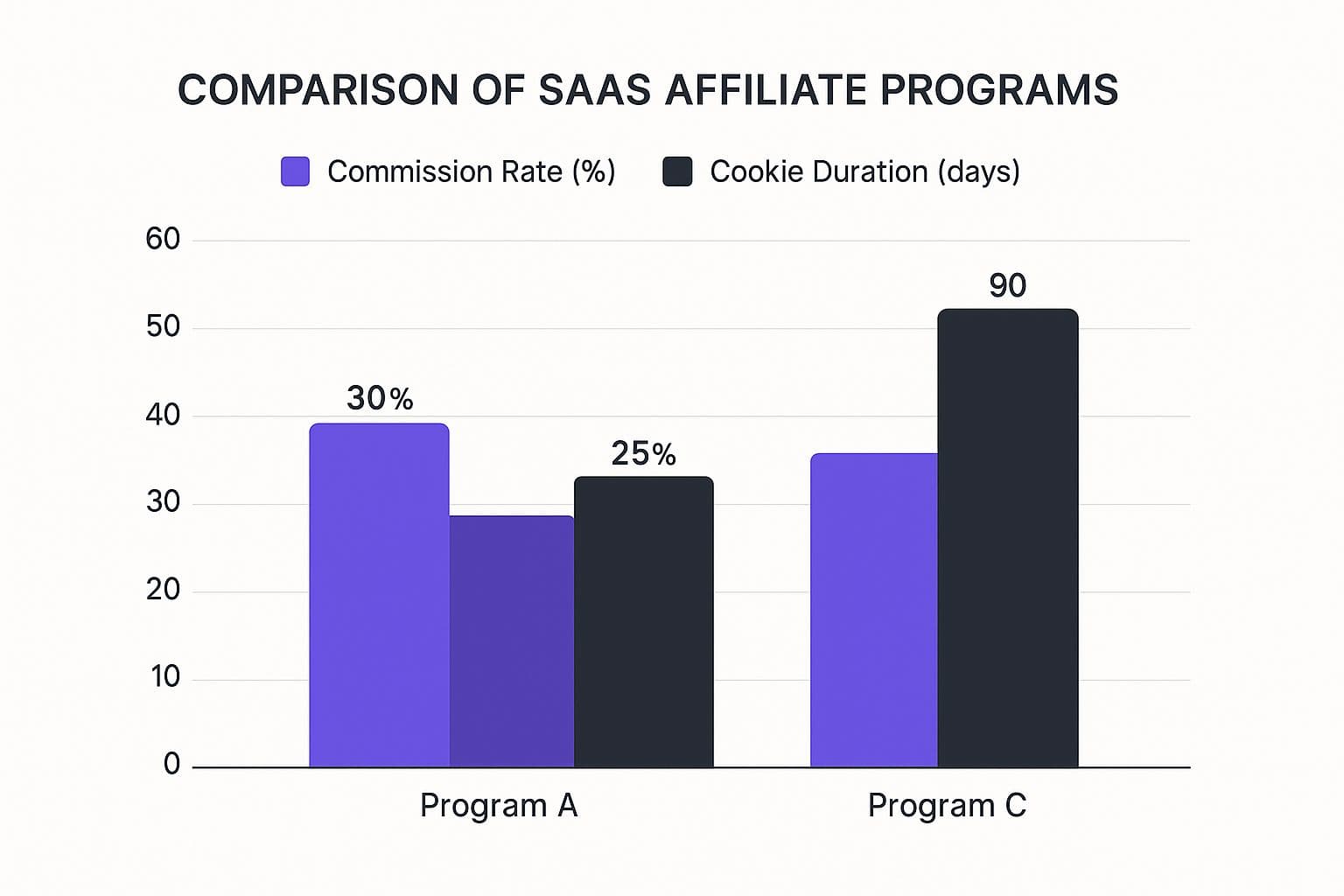
As you can see, a competitive offer is more than a high commission rate. For SaaS, a generous cookie duration is a massive selling point for savvy affiliates.
To find the right partners, use this breakdown to guide your efforts.
Affiliate Recruitment Channel Comparison
| Recruitment Channel | Pros | Cons | Best For |
|---|---|---|---|
| Existing Customers | Highly authentic, genuine product love, high conversion potential. | May lack professional marketing experience, smaller initial reach. | Actionable Use: Getting early wins and building a foundation of authentic advocacy. |
| Competitor Research | Proven track record in the niche, established audience. | May be loyal to competitors, requires a compelling offer to switch. | Actionable Use: Scaling quickly with experienced affiliates who know the market. |
| Influencer Outreach | Large, engaged audiences, strong brand trust. | Can be expensive (fees + commission), requires careful vetting. | Actionable Use: Reaching a large, targeted audience and building brand awareness. |
| Affiliate Networks | Access to a vast pool of pre-vetted affiliates. | Can be costly (network fees), less personal connection. | Actionable Use: Casting a wide net and managing a large volume of partners. |
Choosing a mix of these channels often gives you the best of both worlds: a strong core of brand advocates and the reach of professional marketers.
Creating a Frictionless Onboarding Experience
Once you've found a promising new partner, the onboarding process is your first opportunity to make a great impression. A clunky or confusing start can kill an affiliate's motivation. Your goal is to make it incredibly easy for them to get started and feel confident.
A smooth and clear affiliate registration process is fundamental. The less friction they face at the start, the faster they become productive.
Your onboarding should deliver a fantastic "welcome kit." This is more than a system-generated email; it's a toolkit designed to empower them.
Essentials for Your Affiliate Welcome Kit:
- A Personalized Welcome: A quick, personal video or note from the affiliate manager makes partners feel valued. This is a small touch with a big impact.
- Quick-Start Guide: A one-page PDF showing them exactly where to find their unique affiliate links, how to access marketing assets, and where to view their dashboard.
- Marketing & Creative Assets: Provide a library of high-quality, ready-to-use materials like logos, product screenshots, pre-written email copy, and social media templates. The easier you make it, the more likely they are to start promoting.
- Product Deep Dive: Offer access to tutorials, case studies, and a guide to key talking points. Actionable Step: Grant every new affiliate an extended free trial or a complimentary account. An affiliate who knows the product is a better partner.
- Clear Rules of the Road: A direct link to your program's terms and conditions. Highlight key details like commission structure, cookie duration, and payout schedules to ensure transparency.
By investing time in recruiting the right people and onboarding them effectively, you aren't just gaining affiliates. You're building a powerful network of brand partners invested in mutual growth.
Managing Your Program for Long-Term Growth
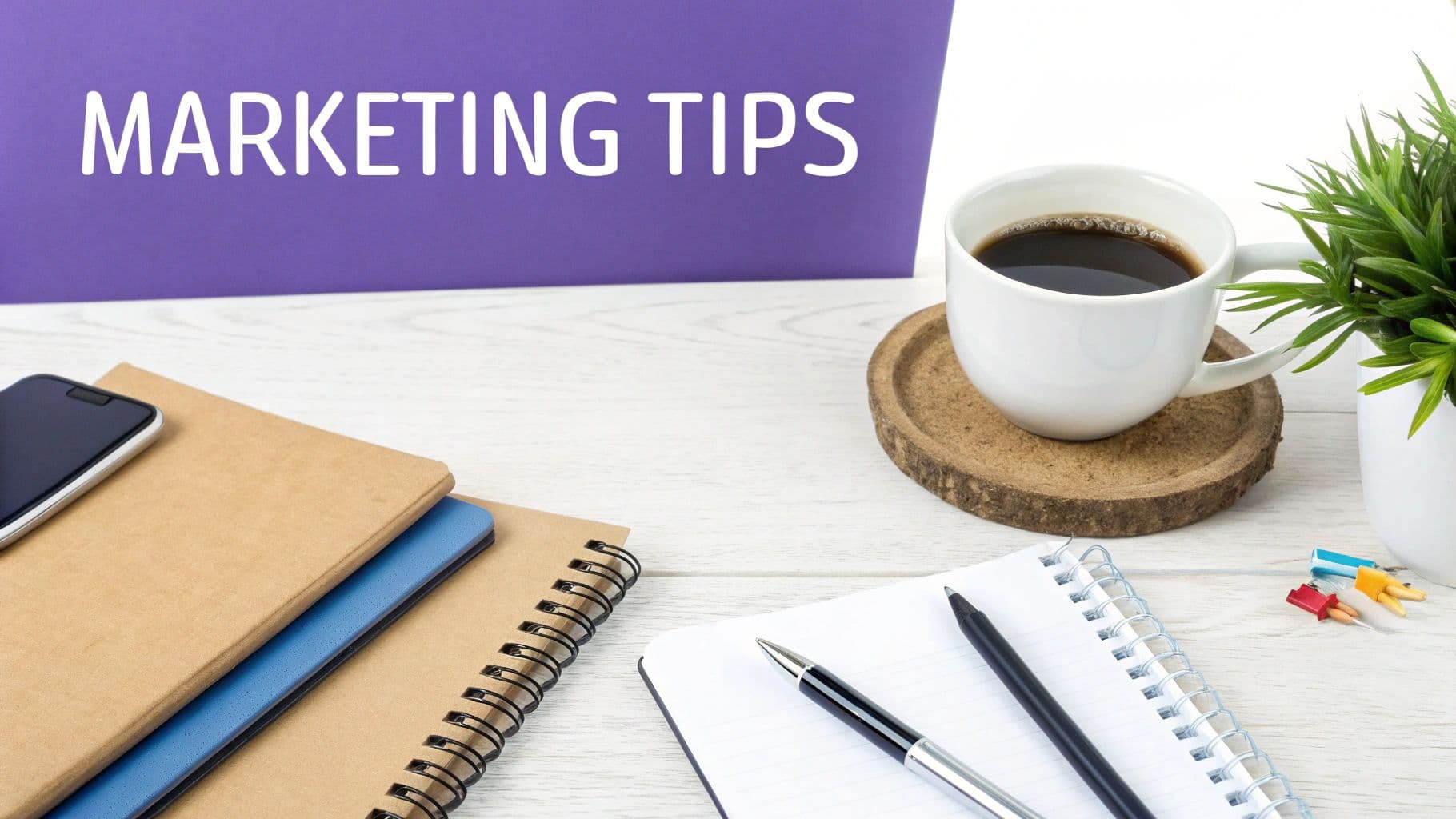
Launching your affiliate program is a great start, but it's only the beginning. The real work—and the source of sustainable growth—is in active, daily management. Too many promising programs fail because they are left on autopilot.
A successful affiliate program is not a "set it and forget it" channel. It's a living part of your marketing ecosystem that needs consistent attention, optimization, and relationship-building. Your goal is to move beyond a simple sales channel and build a predictable, scalable revenue engine by actively cultivating partnerships.
Build Strong Affiliate Relationships
The biggest mistake SaaS companies make is treating affiliates like line items on a spreadsheet. They are an extension of your marketing team. The most successful programs are built on strong, collaborative relationships. Give them a reason to prioritize your product.
Start with personal communication. Ditch the generic monthly newsletter. A quick, genuine email congratulating a top performer on a great month or offering help to a partner who seems to be struggling can make a huge difference.
To make this actionable, you should:
- Provide Performance Feedback: Show you're paying attention. Send personalized tips based on their performance data. Suggest a new content angle or highlight a feature their audience might love.
- Offer Exclusive Promotions: Actionable Step: Create a unique discount code for your top 5 affiliates that they can offer their audience. This exclusivity makes them feel valued and gives them a compelling promotional tool.
- Create a Feedback Loop: Actively ask for their input. Your affiliates are on the front lines and can offer priceless insights into product messaging, customer pain points, and competitor strategies.
An affiliate who feels like a partner will promote your product with more passion. They'll do more than just drop a link; they'll weave your solution into their content, creating authentic and effective promotions.
This hands-on approach directly impacts your bottom line. Building these relationships is a core pillar of managing high-performing SaaS affiliate programs that deliver consistent results.
Monitor the Metrics That Actually Matter
Data is crucial for program management, but it's easy to get lost in vanity metrics. To understand your program's true health, focus on a handful of key performance indicators (KPIs) that show you what's really working.
Tracking the right metrics helps you spot trends, identify star performers, and fix issues early.
Key Metrics to Monitor:
- Affiliate Activation Rate: The percentage of signed-up affiliates who drive at least one click or conversion. A low activation rate (aim for at least 60%) indicates a problem with your onboarding or partner motivation.
- Active Affiliates: How many partners actively send traffic and sales each month? This is a better health indicator than your total registered affiliates.
- Conversion Rate by Affiliate: Not all traffic is equal. Analyzing conversion rates for individual affiliates shows who is sending high-intent traffic versus who is just driving clicks.
- Customer Lifetime Value (LTV) from Affiliates: Are the customers your affiliates refer sticking around? Tracking the LTV of referred customers confirms your partners are aligned with your goal of acquiring loyal users.
Monitoring these numbers allows you to make informed decisions. You can double down on what works with top partners and provide targeted support to those with potential. You can find even more strategies for improving these metrics by checking out our deep dive on other leading affiliate programs.
Keep Partners Engaged with Incentives
Even dedicated partners can lose momentum. Keep them motivated and engaged by running occasional incentive campaigns and contests. This injects fun and friendly competition into the program and gives everyone a reason to push harder.
Instead of relying only on standard commissions, spice things up with time-sensitive promotions.
Ideas for Incentive Campaigns:
- Sales Contests: Offer a cash bonus or a valuable prize (like a free annual subscription to your top-tier plan) to the affiliate who drives the most sales in a given quarter.
- Tiered Bonuses: Create performance bonuses that unlock at different thresholds. For example, offer an extra $100 bonus for every 10 paid customers an affiliate refers in a single month.
- "First Sale" Bonus: To combat a low activation rate, offer a small but immediate bonus to new affiliates for generating their very first sale. This initial win is a powerful motivator.
These campaigns don't require a huge budget. The goal is to break the routine and show your partners they're appreciated. By actively managing relationships, tracking the right data, and keeping partners motivated, you’ll build a SaaS affiliate program that grows stronger and more profitable every year.
Frequently Asked Questions
When you start building SaaS affiliate programs, the same questions always come up. Here are direct answers to the most common queries to help you build a program that performs from day one.
How Much Should I Pay My SaaS Affiliates?
The answer is a balance between being competitive and protecting your margins. For most SaaS businesses, a recurring commission in the 20% to 40% range is the gold standard. This model works because it aligns your partners' goals with your own: finding customers who will stick around.
Actionable Advice: Don't guess. Base your commission rate on your metrics. A smart starting point is to ensure the total commission you pay for a customer's first year is less than your average Customer Acquisition Cost (CAC). If you have a high Customer Lifetime Value (LTV), you can offer a more aggressive rate, like a 30% recurring commission for the customer's lifetime, to attract top-tier affiliates.
While one-time payouts seem simpler, they often attract partners focused on quantity over quality. Recurring commissions are the foundation of a healthy SaaS affiliate program because they incentivize high-quality referrals and reduce churn.
What Is Better: An In-House Program or an Affiliate Network?
This is a classic choice between control and convenience. Your decision will impact your costs, branding, and partner acquisition strategy.
- Going In-House (with dedicated software): This gives you total control. You own the brand experience, build direct relationships, and keep more of your revenue. That direct connection is invaluable for fostering loyalty. The trade-off is that you are responsible for all partner recruitment.
- Joining an Affiliate Network (like ShareASale or CJ): Networks offer a shortcut to a large pool of existing affiliates, which can be great for a quick start. However, you'll pay significant network fees (often 20-30% on top of commissions) and lose that direct, personal relationship with your partners.
Actionable Advice: For most SaaS companies focused on a sustainable, high-quality program, the in-house approach is the better long-term strategy. It allows you to hand-pick partners and cultivate powerful, genuine relationships. To explore platform options, check out our guide to the top-rated affiliate networks.
How Do I Prevent Affiliate Fraud?
A proactive strategy is your best defense against fraud. It's much easier to prevent it than to deal with it later.
Your first line of defense is a clear and comprehensive affiliate agreement. Explicitly forbid prohibited activities like bidding on your branded keywords, cookie stuffing, or making false claims about your product.
Next, ensure your affiliate software includes robust fraud detection features. Modern platforms can automatically flag suspicious activity patterns for your review, saving you significant manual effort.
Ultimately, your most effective weapon against fraud is a thorough vetting process. By focusing on recruiting reputable partners and maintaining open communication, you naturally deter bad actors. Keep a close watch on your analytics for anomalies, like a sudden spike in clicks from one source with zero conversions.
What Key Metrics Should I Track for Program Health?
To truly measure your affiliate program's performance, you need to look beyond top-line revenue. The program's health is revealed by metrics that show partner engagement and the quality of referred customers.
Here are the vital signs to monitor:
- Active Affiliates: Focus on the number of partners driving clicks or sales each month, not your total sign-ups. This is your true active partner base.
- Conversion Rate (per affiliate): This identifies your star performers. Track this for each partner to see who is sending traffic that converts.
- Customer Lifetime Value (LTV): Are customers from your affiliate channel sticking around? A high LTV from affiliate referrals is the ultimate proof that your partners are attracting the right audience.
- Program ROI: This is your bottom line. Calculate the total revenue generated by the program and subtract all associated costs (commissions, software fees). The result shows if your program is a true profit center.
Ready to build a powerful affiliate program that drives predictable, scalable revenue? Push Lap Growth provides all the tools you need—from a fully branded portal and real-time tracking to automated payouts and seamless integrations. Stop paying network fees and start building direct, profitable partnerships. Start your 14-day free trial today!